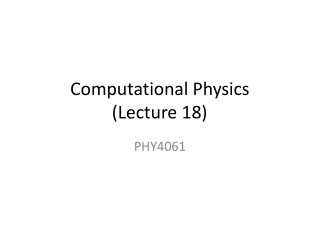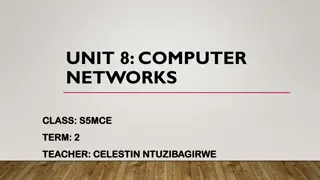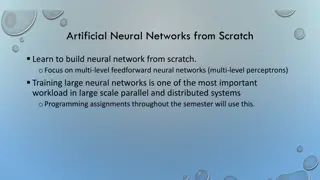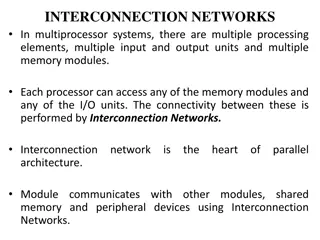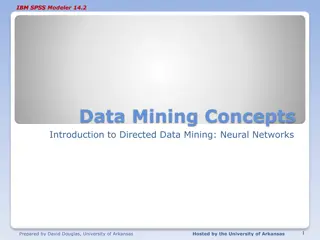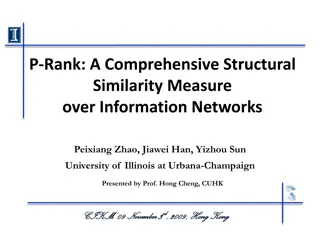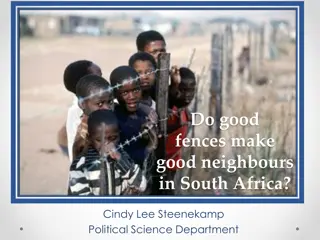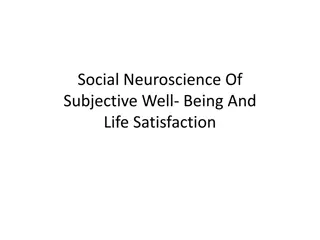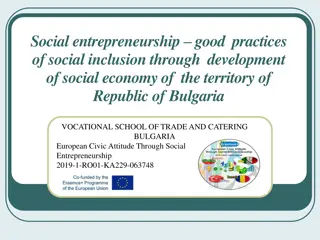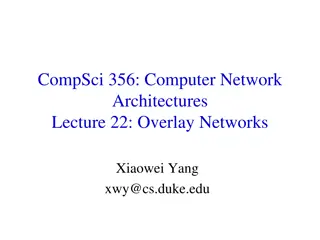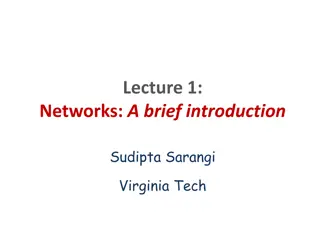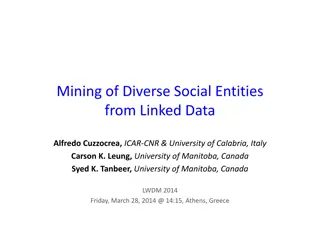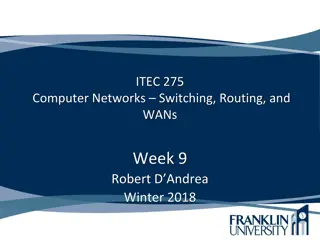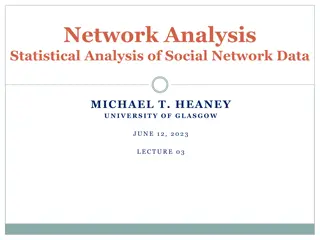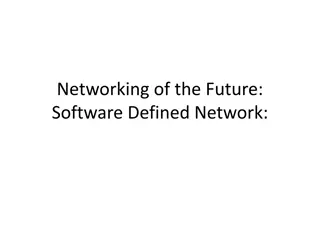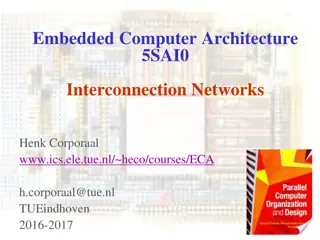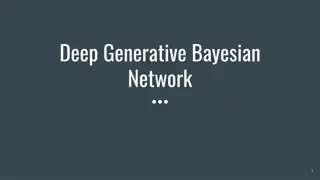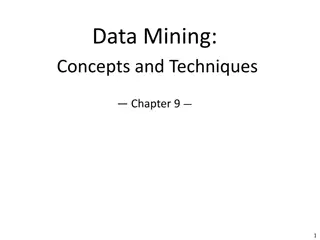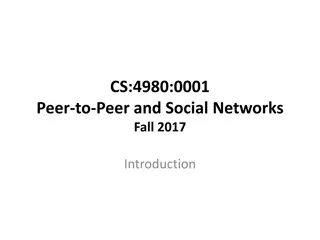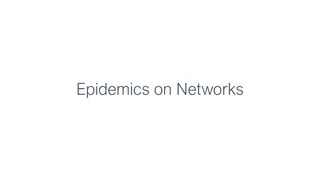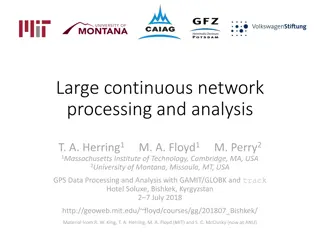
Data Management in Social Networks
This course delves into data management in social networks, covering topics such as modeling, query language design, data mining, data warehousing, and recommender systems. Explore practical applications and challenges in the realm of social network analysis and recommendation systems. Dive into interesting problems involving social networks and gain insights into network modeling, algorithmic issues, marketing, and influence propagation. No formal prerequisites but a basic understanding of graphs, algorithms, data mining, and databases would be beneficial.
Download Presentation

Please find below an Image/Link to download the presentation.
The content on the website is provided AS IS for your information and personal use only. It may not be sold, licensed, or shared on other websites without obtaining consent from the author. If you encounter any issues during the download, it is possible that the publisher has removed the file from their server.
You are allowed to download the files provided on this website for personal or commercial use, subject to the condition that they are used lawfully. All files are the property of their respective owners.
The content on the website is provided AS IS for your information and personal use only. It may not be sold, licensed, or shared on other websites without obtaining consent from the author.
E N D
Presentation Transcript
CPSC 534L: Topics in Data Management Social Networks http://www.cs.ubc.ca/~laks/534l/cpsc534l.html LaksV.S. Lakshmanan Department of Computer Science University of British Columbia
Who I am, what I do, where/when you can find me I do data management (modeling, query language design/optimization, logic + databases), data mining (relational, text, graph and other databases), data warehousing and OLAP, social/information networks and recommender systems. Office: ICICS 315. Home: http://www.cs.ubc.ca/~laks Email: laks@cs.ubc.ca; Phone: 2-3153. CPSC 534L, Intro. 2
Course Practical Matters When & where we meet: MW 9:30-11:00 am, DMP 101. Formal Prerequisites: none. That said, a working knowledge of graphs, algorithms, basic theory, basic data mining/ML, basic DB will be an asset. CPSC 534L, Intro. 3
Course Objective Learn about interesting, useful and challenging problems involving social networks (SN) and recommender systems (RS). Modeling Search/Recommendations Algorithmic Issues Analysis Marketing, Information/Influence Propagation Focus on research. This is not an exhaustive list! As well as other kinds of networks. CPSC 534L, Intro. 4
Course Outline 1/3 Intro: origins, early history, sociologist s perspective, social capital, centrality, social web, web 2.0 and web 3.0, what we care about in this course. Data Mining over Networks: Link analysis & prediction. Team Formation. Community detection. Cocktail Party Planning. Social search. Event Detection from Social Media. Discovering Social Networks. CPSC 534L, Intro. 5
Course Outline 2/3 Viral Marketing: Influence & Information Propagation. Recommender Systems: Content-based vs. Collaborative Filtering Memory-based vs. Model-based. Recommendations of novel objects. Strategic Recommendations. SN & RecSys. Top-k query/search; social content sites and social search revisited. Regrets: An alternative to top-k. CPSC 534L, Intro. 6
Course Outline 3/3 Opinion Mining & Social Networks (time permitting). Student Talks (interspersed with lectures, per topic). CPSC 534L, Intro. 7
Marking Scheme Homework Assignments: 20%. Class Participation: 5% Paper Presentation/Discussion: 30% Course Project: 45% What each of these means for you. Some topics assigned reading. Questions? CPSC 534L, Intro. 8
Plagiarism See http://www.cs.ubc.ca/about/policies/collabora tion.shtml for department policy. Take the time to read it and understand it. Be sure to attribute everything that is not your own original idea/contribution, to the source you got it from. When in doubt, ask me. CPSC 534L, Intro. 9
Resources No text book, but there are excellent books: David Easley and Jon Kleinberg. Networks, Crowds, and Markets: Reasoning About a Highly Connected World. Cambridge Univ. Press, 2010. Available online: http://www.cs.cornell.edu/home/kleinber/networks-book/. Anand Rajaraman and Jeff Ullman. Mining Massive Datasets. Available at http://infolab.stanford.edu/~ullman/mmds.html. K. Faust and S. Wasserman. Social Network Analysis. Methods and Applications. Cambridge: Cambridge University Press. 1994. Carrington, Peter J., John Scott and Stanley Wasserman (Eds.). 2005. Models and Methods in Social Network Analysis. New York: Cambridge University Press. W. Chen, L., and C. Castillo. Information and Influence Propagation in Social Networks. Morgan & Claypool, October 2013. http://www.morganclaypool.com/doi/abs/10.2200/S00527ED1V01Y201308DTM037 Research Literature (WWW, KDD, ICDM, SDM, ICML, WSDM, VLDB, SIGMOD, ICDE, SIGIR, ). Slides. Discussion Report on Papers (for student talks). SN Reading Group: all of you are invited! Send me mail to sign up. CPSC 534L, Intro. 10
Tentative Schedule 1: Intro, DM/N start. 2: DM/N. 3: DM/N, VM start 4: VM 5: VM. 6: RS. 7: RS, Top-K 8: Top-K, Regrets. Schedule may vary dynamically as we adjust to pace. Student talks will be interleaved with lectures. CPSC 534L, Intro. 11
Intro Social Networks are Here 12 CPSC 534L, Intro.
Social Networks Intro. SN didn t quite start like that! From a sociologist s perspective Conventional data is tabular: e.g., R(Name, Age, Gender, Salary). rows = cases , actors , subjects , observations (tuples/users) and columns = variables , measures (attributes). SN data: rows & columns = users*; cell = relationship (ties) between users. (possibly weighted and/or labeled). Matrix/Graph. *groups/communities become nodes too. CPSC 534L, Intro. 13
SN Intro. Simple analysis: which subjects (equiv., variables) are similar? Interestingly, such analysis is frequently employed in RS (Collaborative Filtering!) [Users x Items]. Consider a SN, i.e., a graph of users: similarity between Jack and Jill in terms of their friends. Similarity in terms of whom you like versus who likes you, in the case of directed graphs. Some common measures of similarity: cosine, Jaccard, (Pearson) correlation. Notion of network: friends of user u within h hops; users in a community/group; in a school/class; in an income group; n/w need not be explicitly declared by users. CPSC 534L, Intro. 14
SN Intro. SN often exhibit a power law in a number of ways: Taken from: Networks, Crowds, and Markets: Reasoning About a Highly Connected World By David Easley and Jon Kleinberg Cambridge U. Press 2010. CPSC 534L, Intro. 15
SN Intro. Power law: small #users have a large in-degree; most users have a very small in-degree (observe the long tail). When joining the network, users are more likely to connect to popular nodes. Most of the blogs are posted by a small #users. Most ratings/reviews of movies/songs come from a small #users. #downloads of songs; #citations of papers; populations of cities; #copies of genes in genomes; CPSC 534L, Intro. 16
SN Intro. SN for us is just a graph G = (V, E). Nodes = users/actors/individuals/orgs/entities. Edges = ties/relationships; can be of several types and be complex; can model using labels; can be directed. Social Network Analysis: How do rumors spread (or innovations happen)? How do diseases spread? What is the avg degree of separation of the n/w? Early experiments by Millgram. CPSC 534L, Intro. 17
SN Intro. Millgram s experiments: Controversial version: study how willing normal people are to obey instructions of an authority when the authority instructs them to act against their own conscience. More relevant to SN: measure average min. #ties connecting two random people in the US by asking people to forward a mail to their contacts and seeing how many hops it took the mail to reach a certain target starting from random sources. Precursor of modern-day small worlds experiment. The so-called six degrees of separation: http://www.youtube.com/watch?v=V2biPHBGm3c Leskovec & Horvitz: Microsoft IM large version of Milgram experiment. CPSC 534L, Intro. 18
SN Intro. Social Capital: Oft-used concept; no apparent formal def. in the literature. Here are some example def s. Burt 1992: [Social capital] is the sum of the resources, actual or virtual, that accrue to an individual or a group by virtue of possessing a durable network of more or less institutionalized relationships of mutual acquaintance and recognition. CPSC 534L, Intro. 19
SN Intro. The central proposition of social capital theory is that networks of relationships constitute a valuable resource for the conduct of social affairs, providing their members with "the collectivity-owned capital, a 'credential' which entitles them to credit, in the various senses of the word (Bourdieu, 1986: 249). Much of this capital is embedded within networks of mutual acquaintance and recognition. For our purposes here, we adopt the latter view and define social capital as the sum of the actual and potential resources embedded within, available through, and derived from the network of relationships possessed by an individual or social unit. The fundamental proposition of social capital theory is that network ties provide access to resources. One of the central themes in the literature is that social capital constitutes a valuable source of information benefits. Sirianni & Friedland, 1998 CPSC 534L, Intro. 20
SN Intro Social capital property of a group as a whole versus property of an individual based on its position in the group. E.g., a member may bridge the gap between different groups. Intra-group perspective versus interactions with the outside world perspective. CPSC 534L, Intro. 21
SN Intro. Notions of centrality: (Bidirectional) degree as an indication of info. flow or activity. Betweenness: Boundary spanner between different clusters; how many (shortest) paths pass through me? Potential point of failure. 3 2 7 1 5 6 9 8 10 4 CPSC 534L, Intro. 22
SN Intro. Closeness: how close am I to other nodes, on avg.? E.g. Distance distributions: Node 1 3 5 6 7 Dist=1 5 4 3 3 2 Dist=2 1 3 5 2 1 Dist=3 1 2 1 3 2 Dist=4 2 0 0 1 3 Dist=5 0 0 0 0 1 Just one possible def. closeness(u) = {v G} dist(u,v)/|G|. closeness(1) = 18/10; closeness(5) = 16/10; closeness(3) = 16/10; closeness(6) = 17/10; closeness(7) = 27/10. Any surprises? CPSC 534L, Intro. 23
SN Intro. How vulnerable to single points of failure? How many (central) nodes/links can fail before n/w is disconnected? global measure. How are the various central nodes situated in the n/w? Avg path length in the network. CPSC 534L, Intro. 24
Example Networks Citation graphs, collaboration graphs. SN of corporate members. Wikipedia collaboration graph. Road and subway networks WWW, Internet Water networks Romantic relationships between people Online (social) networks like MySpace, Facebook, Flickr, last.fm, Youtube, MSN IM, ... CPSC 534L, Intro. 25
Social Web How people socialize or interact throughout the www, or more generally, online . Facebook, myspace, twitter, yahoo!360 user-centric; LinkedIn professional. Flickr!, del.icio.us, photobucket, tripit.com item-centric (photos, bookmarks, trip stuff). call-graphs of mobile phone networks. Sometimes used interchangeably with Web 2.0. Sometimes as a future n/w similar to WWW which links, not just docs, but people, orgs, concepts, and resources, make links persistent against changes, resolve trust/privacy issues, promoting greater interoperability. CPSC 534L, Intro. 26
Social Web Social Web (XDI) WWW (http) Internet (TCP/IP) Suppose you could go online and make relevant connections with others from whom you are separated by one, two, or three degrees? Suppose that while working on a solar energy project in California, you could use such a system to find an engineer in Shanghai whose experience is directly relevant to your project? Could the Internet be used to establish networks of trust that cross traditional borders? Can the Internet be better at supporting the ability of citizens to self-organize and participate in civil society? See: Drummond Reed et al. "The Social Web: Building an Open Social Network with XDI", PlaNetwork Journal. July 2004. CPSC 534L, Intro. 27
Web 2.0 Connect to users not just to docs. Social Networking [Facebook]. Collaboratively create content, not just view existing content passively. Collaborative tagging (folksonomy) [del.icio.us], rating, reviewing [amazon], blogging., wikipedia. Share content [youtube]. RSS Feeds (change subscription). Hosted services, mashups, ... Non-conventional access devices (mobile phones, game consoles, TV(?)). CPSC 534L, Intro. 28
And Web 3.0. Complex (i.e., composite) search: e.g., find a good camping site within 500 km of Vancouver, near a lake with kayak rentals, making sure the rental is working in the season OR find a nice comedy in town and a good resto with spicy food nearby OR find a good tropical destination for summer vacation that I can do in 1 week, in under $4000, which is family friendly. What is the best way I can fly to Tahiti under the current weather conditions? CPSC 534L, Intro. 29
More on Web 3.0 Web 3.0 browser searches diff. Internet sites and integrates and organizes info. for you. Research on heterogeneous DBs is relevant. CPSC 534L, Intro. 30
More about Web 3.0 Vague searches: where should I go for dinner with my friend visiting from Africa? Your browser knows your profile based on past behavior and uses that to generate a recommendation. Web 3.0 feels like a gigantic DB of everything, including you, your habits, preferences, actions, behavior, ... Scary prospects for privacy! "We don't need you to type at all. We know where you are. We know where you've been. We can more or less know what you're thinking about, Eric Schmidt, CEO, Google. CPSC 534L, Intro. 31
More on Web 3.0 Knowing your search context: the tropical vacation search could trigger related activites/things to dobased on collaborative filtering, but taking constraints into account. Personalization: the answer you get, for a given search query, depends on who you are, profile-wise. Web 3.0 is supposed to allow anyone to create a mashup! Supposed to leverage RDF & ontologies. Ontology authoring and maintenance too complex for most people. lot of interest in discovering ontologies from tagging data (folksonomy). Pretend all the info. you need is on a gigantic structured DB. How would you make many of the above a reality today? CPSC 534L, Intro. 32
Our focus in the course Technology is great, but underlying principles, formal foundations, theory, algorithms are more fun. Emphasis on creativity and research challenges. CPSC 534L, Intro. 33

